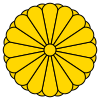
Arisugawa-no-miya
Encyclopedia

Shinnoke
was the collective name for the four cadet branches of the Imperial Household of Japan, which were until 1947 entitled to provide a successor to the Chrysanthemum throne if the main line failed to produce an heir...
, branches of the Imperial Family of Japan
Japan
Japan is an island nation in East Asia. Located in the Pacific Ocean, it lies to the east of the Sea of Japan, China, North Korea, South Korea and Russia, stretching from the Sea of Okhotsk in the north to the East China Sea and Taiwan in the south...
which were, until 1947, eligible to succeed to the Chrysanthemum Throne
Chrysanthemum Throne
The is the English term used to identify the throne of the Emperor of Japan. The term can refer to very specific seating, such as the takamikura throne in the Shishin-den at Kyoto Imperial Palace....
in the event that the main line should die out.
The Arisugawa-no-miya house was founded by Prince Yoshihito, seventh son of Emperor Go-Yōzei (d. 1638), and was originally named Takamatsu-no-miya. The house changed its name to Arisugawa-no-miya after its 2nd head, Prince Nagahito was elevated to the throne as Emperor Go-Sai.
The Arisugawa-no-miya house traditionally served as instructors in calligraphy and tanka poetry to successive generations of Emperors, but after the Meiji restoration
Meiji Restoration
The , also known as the Meiji Ishin, Revolution, Reform or Renewal, was a chain of events that restored imperial rule to Japan in 1868...
played important roles in the early Japanese military.
The Arisugawa line ended early in the twentieth century when no male heirs remained. However, the Imperial Household Agency revived the original title of Takamatsu-no-miya for the third son of Emperor Taishō
Emperor Taishō
The was the 123rd emperor of Japan, according to the traditional order of succession, reigning from 30 July 1912, until his death in 1926.The Emperor’s personal name was . According to Japanese customs, the emperor has no name during his reign and is only called the Emperor...
. The line again became extinct on Prince Takamatsu
Prince Takamatsu
was the third son of HIM Emperor Taishō and HIM Empress Teimei and a younger brother of the HIM Emperor Shōwa . He became heir to the Takamatsu-no-miya , one of the four shinnōke or branches of the imperial family entitled to inherit the Chrysanthemum throne in default of a direct heir...
Nobuhito’s death, as he had no children.
In 2003, an impostor to the Arisugawa line appeared, and stole a great deal of money.
| Name | Born | Succeeded | Resigned | Died |
| 1 |
|-
| 2 || || 1638 || 1647||1654||1685
|-
| 3 || || 1656 || 1667 || .||1699
|-
| 4 || || 1694 || 1699 || . ||1716
|-
| 5 || || 1713 ||1716 || . || 1769
|-
| 6 || || 1755 || 1769 || . || 1820
|-
| 7 || || 1784 || 1820 || . || 1845
|-
| 8 || || 1813 || 1845 || 1871 || 1886
|-
| 9 || || 1835 || 1886 || . || 1895
|-
| 10 || || 1862 || 1895 || . || 1913
|-
| ※ || || 1903 || 1913 || . || 1987
|}
※In Imperial Household Law
Imperial Household Law
is a statute in Japanese law that governs the line of imperial succession, the membership of the imperial family, and several other matters pertaining to the administration of the Imperial Household.-Passage of the Law:...
at that time, the house of an imperial prince was not admitted to be succeeded to by taking away the adopted son. Prince Nobuhito newly founded the Takamatsu-no-miya. Therefore, Prince Nobuhito is not the eleventh generation but the first Takamatsu-no-miya.

